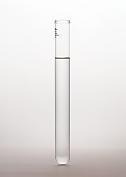
こんにちは、イギリスから来たケイトです。
現在、当院で胚培養士として働いています。
胚移植において、子宮収縮、カテーテルの種類、挿入方法、胚の子宮内移植位置などは胚着床に大きく影響すると考えられています。
A Glance into the uterus during in vitro simulation of embryo transfer.
Osnat et al. Human Reproduction Vol.19, No.3 pp 562-569., 2004.
上記論文は子宮内を想定した模型を使って、胚移植時の子宮内の液体の分布と注入する液体の粘性について検討しています。
当院では、移植の際カテーテル内を約100µlの培養液で満たし、カテーテルの先端は10µlの空気、10µlの移植胚を含んだ培養液、10µlの空気の順に移植胚をカテーテルに吸引します。
これは挿入の際に移植胚が途中でこぼれてしまわないように空気でふたをするためです。
論文では空気と培養液の量を変えることで、培養液の拡散の違いを評価し、培養液注入時に、培養液とともに前後に吸引した空気がカテーテルから出てきた際にくっついて一つの泡になり、その泡が培養液の前方への拡散を阻害したと報告しています。
さらにカテーテル内を空気または当院と同様、培養液で満たした場合を比較し、液体で満たしたほうが注入時の泡が小さく培養液の拡散を阻害しなかったと報告しています。
移植胚吸引時の空気が挿入の際の液漏れを防止するうえで必要だとも報告しています。
これは当院の方法の正当性を証明してくれています。
多くのARTの技術は成功のために如何に自然な胎内環境を再現できるかが重要とされています。
論文では子宮内液の粘性を再現しようと試みています。
子宮内液と同等の粘性のあるものに液体を置き換えたところ、泡の阻害を大きく受けることなく散布されたと報告しています。
注入は毎回同様の方法で行われますが、実際の移植では他にもいろいろな因子が着床の成否に関与していることが考えられます。
当院では着床率の上昇を目的として、普通の培養液に比べて粘性が高く、ヒアルロン酸を含むembryo glueを必要に応じて使用しています。
———
Greetings, I’m Kate. I am from England and work as part of the Embryologist team. Embryo transfers (ET’s) involve mechanical factors including uterine contractions, catheter type, catheter loading methods and optimal positioning of the tip with the aim of depositing the embryo as close as possible to the fundal wall to provide optimal conditions for successful implantation.
A Glance into the uterus during in vitro simulation of embryo transfer.
Osnat et al. Human Reproduction Vol.19, No.3 pp 562-569., 2004.
Two technical aspects of ET’s were evaluated using a transparent model of the uterine cavity. Firstly the transportation and distribution of liquid with air and secondly different viscosities between the transferred liquid and uterine fluid, these mock ET’s were digitally recorded and analyzed.
At Oak Clinic, the catheter is loaded with 100µl of blastocyst medium, a 10µl gap of air prevent transport of the embryo into the catheter, 10µl of medium and embryo and finally 10µl of air to prevent any spillage.
This study evaluates different loading combinations of liquid (Saline) and air.
After injection, the air came from the catheter tip, the two small volumes of air inside the catheter tube formed one larger air bubble, blocking the transfer of liquid forward and distributing it back towards the cervix.
When 100µl of air was replaced with 100µl of liquid, a smaller air bubble forced the liquid to the sides but closer to the fundus, this supports our protocol. Air at the end of the catheter is necessary to avoid liquid spillage upon insertion.
Many ART procedures try to mimic natural mechanisms and environments that enhance success, so they try to match the viscosity of uterine fluid, assumed to be between 1500-2500 centipoise (cp) depending on the phase.
Replacing saline with glycerin-1880 cp, the transferred liquid spread around the bubble, liquid dispersion was limited and perhaps less likely to head towards the cervix. A constant velocity was used for all injections, but this varies in real ET’s alongside other mechanical factors.
We regularly use embryo glue that has a high viscosity and contains hyaluronan to increase implantation rates.
